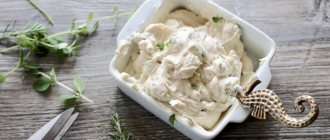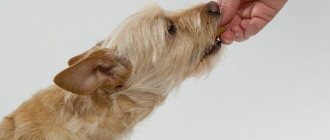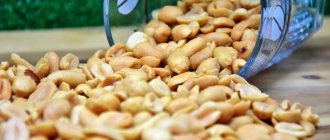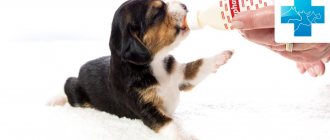The health of our pets largely depends on how high-quality and varied products we feed them. It is wrong to give your dog exclusively meat. – the tailed friend will not receive all the necessary vitamins and minerals from it. Are dairy products, in particular cottage cheese, allowed for dogs?
Role in the human diet
People have been using cottage cheese for a long time. It is made by heating natural milk and expressing the whey that is released. For people, it is a real storehouse of useful substances : amino acids, vitamins A, E, C, B1, B2, B12, a number of useful microelements: potassium, calcium, sodium, magnesium, phosphorus, iron, zinc, copper, fluoride, lack of lactose , and most importantly - how much protein!
Indeed, cottage cheese compares favorably with other dairy products precisely because of its high protein content. In addition, during the fermentation process, the casein protein coagulates, and this increases its digestibility . This protein perfectly saturates the human body and is involved in the process of formation and restoration of muscle tissue. Calcium and phosphorus serve as materials for building bone tissue and strengthening teeth.
Cottage cheese is recommended for everyone to eat - children, the elderly, expectant mothers, athletes, and workers in hazardous industries.
Like any other product, cottage cheese in excessive quantities will not bring benefit, but harm:
- Eating a lot of fatty foods will increase your blood cholesterol levels.
- Frequent consumption can cause kidney problems due to the high protein content.
- This is a perishable product. It’s easy to get poisoned by expired or low-quality products.
Important: The shelf life of any cottage cheese is no more than 3 days after opening the package.
Frequently asked questions and answers
Is it possible to use cottage cheese to normalize intestinal function in a dog?
It is believed that cottage cheese can normalize a dog's intestinal function, however, if your dog exhibits symptoms of acute intestinal distress for more than 24 hours, it is best to consult a veterinarian who can perform appropriate diagnostics to pinpoint the problem and create a specific treatment plan. The fact is that often a gastrointestinal disorder can hide another serious pathology. This is what needs to be excluded at this moment.
Is cottage cheese suitable for feeding dogs with diabetes?
Any additional foods, even those that are low in carbohydrates, can have a big impact on your dog's blood insulin levels. It is very important to stick to the feeding and food schedule that you decide with your veterinarian.
Remember that finding the right dose of insulin for your dog can be difficult, and you will likely have several consultations with your doctor to find the dose. Therefore, be careful when introducing new foods to your dog with diabetes. This applies not only to cottage cheese.
Will cottage cheese help with dry skin on a dog?
There is no evidence that dry cottage cheese has a positive effect on your dog's skin. If you are concerned about your dog's skin, it is best to talk to your veterinarian. He will be able to diagnose the problem if there is one.
Is cottage cheese good for nursing dogs?
Lactating dogs can certainly consume more calories in their diet, but it should be from a balanced food source, which cottage cheese is not.
Some people think that the calcium contained in cottage cheese makes it more suitable for nursing dogs, but calcium is one of the most important nutrients that needs to be balanced with other nutrients, as nutritional problems can develop in mom and puppies if this balance will be broken!
For pet
Benefit
This product is very useful for people - this is what owners are guided by before treating their dog with cottage cheese. Indeed, animals also need it . First of all, as a source of easily digestible calcium, necessary for the development and strengthening of the animal’s skeletal system and protein, which is of decisive importance for the dog’s health.
If there is enough protein in the diet, the dog will be active and strong. Cottage cheese is also good for dogs:
- the presence of amino acids that help the functioning of the gastrointestinal tract and nervous system. They are also responsible for the activity of mental activity;
- iron – is responsible for maintaining the required level of hemoglobin;
- Vitamin A is good for vision, helps to form strong teeth and bones, and it also normalizes metabolism. It also stimulates the immune system and helps fight infections. This is why cottage cheese is so beneficial for puppies;
- Vitamin D is also important for puppies; the health of the musculoskeletal system depends on it.
Harm
Sometimes after eating cottage cheese the animal becomes ill, but this is more of an individual reaction . And yet, such a useful product can harm your dog if:
- you feed your dog fatty cottage cheese - this will test the dog’s gastrointestinal tract. The liver cannot cope with such a load;
- the dog is getting too much product . Oddly enough, an excess of calcium in the body also negatively affects the growth and structure of bones;
- it is consumed by a large breed puppy - they already grow quickly, and an additional source of calcium will lead to pathologies;
- the dog is obese or has pancreatitis - in these cases it needs to be fed a special diet, without any disturbances;
- The dog is allergic to it. By the way, if a dog is allergic to beef, there is a high probability that he will also be allergic to cottage cheese. On the contrary, this rule also works;
- This product does not mix well with dry food . For drying dogs you will have to select it individually.
Is there lactose intolerance in dogs?
Some dogs may be lactose intolerant and therefore do not tolerate dairy products well.
If you are lactose intolerant, the permissible dose of cottage cheese per day is no more than one tablespoon.
Lactose is a type of sugar found in milk and dairy products. Newborns produce the enzyme necessary to break it down, but after puppies stop drinking their mother's milk, their bodies stop producing the enzyme.
The digestion process includes a fermentation stage in which bacteria break down lactose. Fermentation means it will contain much less lactose and can be consumed by even adult dogs.
High levels of lactose in an adult dog's diet can cause stomach upset.
Store-bought or homemade?
There are no clear pros and cons here. It is impossible to find out what store-bought cottage cheese At the same time, E. coli multiplies well in it, so buying it secondhand without knowing anything about the manufacturer’s certification is dangerous.
Farm-made is not always of high quality; the cleanliness of the one who makes it, the health of the cow and what kind of food she eats are very important. The percentage of poisoning from homemade cottage cheese is higher than from store-bought cottage cheese.
Important: dogs are not given “curd product”. Also refrain from feeding your pet curd cheeses and curd mass. You cannot buy cottage cheese with raisins and other additives.
When buying it in a store, carefully read the ingredients . Sugar, vegetable fats, sweeteners, dyes, soy, starch, preservatives, palm oil - all these “healthy” ingredients indicate that you should not buy the product. Give preference to the shortest possible composition and minimum shelf life.
Advice: cottage cheese must be made according to GOST, and not according to specifications - each manufacturer has its own, and it is not a fact that it is of high quality.
Look at the price too. This product is not cheap. When purchasing a product on the market, ask for a quality certificate and a veterinary certificate - this way you will protect yourself. It's best to buy from friends.
Tip: take a little cottage cheese in your hand. If it is very dry and crumbly, the product is guaranteed to be diluted with flour to increase the quantity and give it a marketable appearance.
Supplements to the basic diet
It’s hard to imagine a complete diet for a two-month-old puppy without fortified supplements and “snacks.” The main thing is to know which and how much you can give.
Vitamins and minerals
Mineral and vitamin supplements are not needed when feeding prepared foods. The dryer already contains all the necessary components. If additional drugs are administered, this will lead to hypervitaminosis.
But natural nutrition is difficult to balance. Therefore, vitamins and minerals are required.
There are 2 types of vitamin and mineral supplements:
- Industrial.
The best are considered to be 8 in 1 Excel Multi Vit, Canvit Junior, Beaphar for puppy, Biorhythm, Doctor Zoo. - Natural.
Brewer's yeast, feed sulfur, bone meal, calcined cottage cheese, fish oil.
Puppies of large breeds (for example, VEO, St. Bernard, Rottweiler, Alabai, Samoyed) are given calcium, phosphorus and magnesium for the proper formation of bones and joints.
And in winter, fish oil and vitamins A and D are recommended for 2-month-old kittens to prevent rickets.
Goodies and treats
Any dog is sure that a day without a treat will be in vain. To please your pet and not harm her, select healthy treats:
- Ready from stores.
Dried offal, dried meat without salt and seasoning, deer antlers, cookies, sinew bones. - Made at home.
Bread crumbs, oven-dried meat, hard unsalted cheese.
Giving a 2-month-old puppy unlimited amounts of treats is prohibited. This is just a way to please your baby, encourage good behavior, develop a necessary habit, or teach a command.
The maximum daily amount of treats is no more than 10% of the total diet.
Recommended fat content
Depending on the fat content, it is divided into:
- fat – 18%;
- bold – 9%;
- low-fat – less than 8%;
- low fat.
For dogs, it is better to take half-fat cottage cheese , since a high-fat product will be difficult to digest. This will cause dysbiosis and other digestive problems.
You shouldn’t give it low-fat : the less fat, the worse the absorption of calcium, for which the animal is given a treat.
Interesting: medium-fat cottage cheese is also the healthiest for humans. During production, it is processed the least (increasing or decreasing fat content), so that the beneficial substances are perfectly preserved.
For each individual, fat content should be selected individually. Sometimes it happens that a certain brand and fat content of a product makes an animal feel unwell. Don't be afraid to experiment and you will find “your” cottage cheese. Focus on the dog's mobility and health:
- Inactive animals, bitches weakened after pregnancy, elderly animals, as well as those suffering from obesity and digestive problems can be offered low-fat cottage cheese (but not lower than 2-3%).
- Puppies, working dogs and simply playful active animals will benefit from a higher calorie diet – up to 11%.
What is better for a puppy: natural food or ready-made food?
There are 2 types of dog food - natural and ready-made food (dried, canned). Which diet is better - there is no clear answer.
Some owners or breeders believe that it is impossible to balance a puppy’s diet on a natural menu: in order to calculate the calories, vitamins, minerals consumed by the dog and their expenditure, a laboratory is needed. Others believe that industrial feeds are divorced from natural nutrition and you cannot be sure of the quality of the products.
- “Naturalka” takes time to purchase products, prepare and create a menu. This option is unlikely to be suitable for busy owners.
- It is not recommended to mix natural and prepared diets even at different meals.
- Ready-made meals will save time, but will cost significantly more. After all, you will have to buy high-quality food for your puppy. Feeding “economy class” food to children is not acceptable.
How often to give?
Cottage cheese and other dairy products are not natural food for animals. For this reason, many veterinarians do not include them in the diet of an adult, except as a treat. At the same time, domestic dogs have been living side by side with us for so long that they have already managed to adapt. So you shouldn’t give cottage cheese too rarely.
The role of cottage cheese and other fermented milk products for a pet echoes the role of vegetables . All this together creates a healthy prebiotic environment that helps in the functioning of the stomach, preventing gastrointestinal diseases and allergies.
Important: your dog may be a staunch opponent of cottage cheese. Don’t force her; if she doesn’t want to, don’t eat it; there are various substitutes for the product.
Is it possible every day and how many grams?
For an adult dog, it would be correct to give cottage cheese 1-2 times a week, completely replacing the meat diet with fermented milk on this day. Or 3-4 times a week, 100 g, mixed into the main meal. It is not recommended to give more often - this will cause problems with excess protein and calcium, and loose stools may begin.
If your dog is overweight, you can develop a diet based on cottage cheese, but this must be done with a veterinarian . The product is perfect for diets with low protein: its protein is lighter compared to meat. In these cases, the product can be given daily.
Does cottage cheese cause gas, diarrhea or constipation in a dog?
Can cottage cheese cause diarrhea, constipation and gas in a dog?
Any sudden changes in diet may cause diarrhea or gas, if your dog is trying this for the first time, his intestines may be sensitive to this product. If you notice that your dog has diarrhea for more than 2 days, you should remove cottage cheese from the diet, and if this does not help, then consult a veterinarian.
It is unlikely that cottage cheese will cause constipation in your dog. Therefore, if you notice that your dog has not had a bowel movement for more than 48 hours, you should talk to your doctor to figure out what to do next.
For puppies
Cottage cheese is one of the first complementary foods introduced to puppies. At the age of 3-4 months it is considered a complete feeding and can be given 50/50% with meat. Take regular, not very fatty cottage cheese. But it should be softer than for an adult dog - the consistency of thick sour cream. To do this, mash it with a spoon and add kefir.
It is recommended to add prescribed vitamins and probiotics to “curd feeding” for puppies.
A puppy under one year old, especially if he is a large breed, can occasionally be given calcined cottage cheese, but without getting carried away with it. Excess calcium leads to hypercalcemia, a very unpleasant disease.
Reference: Calcined cottage cheese is a fermented milk product to which a solution of calcium chloride is added (in droppers, ampoules, bottles) or calcium lactate in powder. You can buy it at any pharmacy. This product contains more calcium than usual, promotes healthy growth, strengthens bones and teeth, and maintains muscle tone in the puppy. It is given to prevent rickets.
How to properly feed your dog cottage cheese
For your pet, choose cottage cheese with medium fat content – 5% – 9%. Products with higher fat content cause diarrhea. And from low-fat diet, calcium is absorbed worse.
Farmer's cottage cheese is characterized by increased fat content. It is not given to dogs.
When purchasing fermented milk products in the supermarket, pay attention to the expiration dates. Choose cottage cheese that the manufacturer has specified as short as possible. They do not contain chemical preservatives.
Cottage cheese with the addition of raisins, dried apricots or chocolate pieces is not suitable for feeding animals. For your pet, choose a product without sugar or sweeteners, with the shortest possible composition.
Cottage cheese is given to adult pets 3 – 4 times a week. It is mixed with other products. For example, porridge (rice, buckwheat, rolled oats). Add no more than 100 grams.
Another feeding option: cottage cheese is given to the pet 1 – 2 times a week. The product replaces one of the meals. For better absorption, fruits or vegetables are added to it. For example, apple, carrots, zucchini.
It is permissible to mix cottage cheese with low-fat sour cream or kefir. Fermented milk products are combined with chicken or quail eggs.
Cottage cheese is used as complementary food for puppies. It is administered to pets from three to four months, mixing 50:50 with meat.
For puppies, choose medium-fat cottage cheese. It is diluted with kefir to the consistency of thick sour cream. Vitamins and probiotics prescribed by a veterinarian are added to this fermented milk product.
For large breed puppies, it is permissible to make calcined cottage cheese once a month to prevent rickets. A solution of calcium chloride or calcium lactate in powder, which are sold in pharmacies, is added to the fermented milk product. You should not overuse such feedings, as this leads to hypercalcemia.
Source
Recipes with cottage cheese for animals
The main rule is not to mix cottage cheese with meat, but you can mix it with cereals (rice or buckwheat) and vegetables. Try these recipes:
- 250 g of cottage cheese, a small carrot and half an apple, a spoon of sour cream. Boil and grate the carrots, cut the apple, mix with cottage cheese and pour over sour cream.
- Beat the cottage cheese in a blender with pre-diluted gelatin. You can add a little natural yogurt. This is a very healthy dessert for bones and joints.
- Mix cottage cheese with buckwheat, beat in an egg (yolk only), and grate the carrots if desired. Nutritious, tasty and suitable for frequent feeding!
Cottage cheese for puppies: 100 g of cottage cheese, 1 tsp. butter, 1 yolk, 100 g ground oatmeal. Grind the cottage cheese with the yolk and butter, mix with oatmeal. Keep the stirred mixture in a water bath for 10 minutes. You can make balls out of it and give it to the animal as a reward.
How to determine the correct serving size?
New owners of two-month-old puppies often go from one extreme to another: either it seems to them that they are overfeeding the baby, or they think that they are underfeeding.
Both overeating and undereating are bad. But for the health of the heart and joints, it is better to slightly (just slightly!) underfeed your dog. This advice is especially useful for large breeds (such as German and Caucasian Shepherds, Alabai, VEO), whose bones and ligaments are already under heavy stress.
The amount of daily food should be approximately 5-7% of the dog’s weight or 260-270 kcal per 1 kg. But this is an average rule.
You can more accurately determine what portions to give your puppy at 2 months.
Place a bowl of food. Normally, the baby eats food in 10-15 minutes and licks the bowl a couple of times. If after 15-20 minutes there are food left, you are overfeeding the dog. If your pet swallows a portion in 2-5 minutes and licks the dishes for a long time, you are underfeeding.
There is another option. Give the puppy a known large portion. Keep an eye on the dog: as soon as the last (false) ribs are visible, take the bowl away. This way you will slightly underfeed the dog. This method is used for hunting breeds of lean build - shorthaired pointer, drathaar, Russian hunting spaniel.
There is no such problem with ready-made food. The package indicates the exact daily drying volume based on the weight of a two-month puppy. The only thing is that the amount sometimes has to be adjusted if the baby has an accelerated or slow metabolism.
What if you feel sick from what you eat?
After eating cottage cheese, your dog may develop diarrhea. If the product was stale or of poor quality, poisoning is likely. If these symptoms occur, contact your veterinarian. You can help yourself like this:
- For diarrhea , give activated carbon (at the rate of 1 tablet per 10 kilos of live weight), keep it in water for a day without any food. Make sure your dog drinks a lot!
- If poisoned, you will experience diarrhea, abdominal pain, refusal to feed, weakness and lethargy or unnatural agitation. Induce vomiting by giving the animal a very weak solution of potassium permanganate. Give activated carbon.
Basic feeding rules
Two months is the most difficult age for puppies. They experience stress after stress: moving to a new home, first vet visits and vaccinations, meeting new people, places and animals. In addition, two-month-old kittens grow rapidly: from 8 to 12 weeks their weight doubles.
Let's look at the basic rules that should be taken into account when feeding puppies.
For the first 2 weeks after purchasing the baby, he is fed the same food as the breeder
. Only in the 3rd week do they change the diet, introducing new products and gradually increasing their volume. If you immediately transfer the puppy to a new menu, disruption of the gastrointestinal tract is guaranteed.
The approximate diet for two-month-old kittens consists of: 40-45% meat, 35-40% dairy and fermented milk products, 15-30% vegetables, cereals and other foods
. But these proportions are approximate and depend on the breed (naturally, the needs of a Yorkie and a Shepherd are different), size, gender and individual development of the dog.
Meat is the main component.
It is given at the rate of 15-30 g per 1 kg of weight per day. However, the calculations are again approximate and depend on individual factors.
For example, bulldogs feel great on a low-protein diet, while huskies have only 25 g of meat. Here they focus on the characteristics of the breed and the well-being of the baby.
Food temperature – room temperature or slightly higher
. Hot and cold foods irritate the esophagus and stomach.
An important question is how many times a day should you feed a two-month-old puppy?
Food should be given 5-6 times a day at regular intervals.
By the 3-4th month, reduce the number of meals to four. Avoid night feedings after 10-11 pm - the baby’s stomach should rest.
Feeding should be done every day at a certain time
to develop a diet.
Provide constant access to water.
It is recommended to change the water 2-4 times a day, because... When drinking, food debris, saliva, fur, and dirt get into the liquid.
It is advisable to use bowls with a stand.
Their height is adjustable so that the pet keeps its neck straight without stretching it up or down. Otherwise, a high load is created on the shoulder girdle, which over time can lead to deformation of the skeleton.
Remember that it is at 2 months that the puppy develops eating habits and the concept of a routine. Instill a love for quality nutrition by the hour and you will get a healthy, hardy dog.
Other dairy products
- cheese - only hard varieties are allowed as a delicacy and encouragement during training;
- milk is good for puppies. In adulthood, it is not absorbed by all dogs;
- sour cream is too fatty and is prohibited for constant feeding. You can mix a little into the cottage cheese;
- kefir - like cottage cheese, it can and should be given from puppyhood. Serves as a good replacement for milk in adulthood. Helps digestion, is perfectly absorbed;
- cream - used for artificial feeding along with eggs and milk. It should not be given to adult dogs: it is too fatty and causes diarrhea.
Basic prohibitions
There are foods that are undesirable or strictly prohibited to be given to two-month-old puppies. Of course, the first thing that is dangerous is constant feeding of junk food. But even an accidentally eaten piece can cause serious consequences.
It would seem that a tiny piece of chocolate or sausage once a month will not affect the puppy’s health. But it's not that simple. The product may not harm, for example, a large husky. But for small Shih Tzus or Chihuahuas, a dose of dangerous ingredients in a piece will be fatal.
Strictly prohibited and “controversial” products
Absolutely harmful to all puppies:
- salty, spicy, smoked, fried, fatty foods;
- semi-finished products and fast foods;
- sausages, canned food, marinades;
- garlic, onion;
- citrus fruit;
- sweets (especially chocolate), confectionery and bakery products;
- grapes, raisins;
- tubular bones of poultry, fish, leather;
- mushrooms, nuts;
- alcoholic, carbonated, sweet drinks.
Some of these products lead to health problems if consumed regularly. Others immediately cause intoxication, allergies, and gastrointestinal disorders.
There are products that some owners consider undesirable, while others consider them harmless if consumed rarely. This:
- pork - raw meat is fatty, may contain helminths, but boiled meat can be fed occasionally;
- potatoes are pure starch when boiled, but you can treat them with 1-2 slices of raw root vegetables;
- tomatoes - a large amount can lead to poisoning, but in small doses they remove plaque from teeth;
- honey is an allergen, but at the same time a storehouse of useful substances;
- semolina and pearl barley are pure carbohydrates and cause bloating, but porridge with milk helps exhausted babies at 2 months to gain weight;
- peas, soybeans, beans, beans, corn: they cause gas formation and are difficult to digest, but if the dog loves them, a few grains will not harm.
Alternative
Many owners limit their dog's diet to only cottage cheese and kefir. Meanwhile, the animal - as an alternative to cottage cheese - can be given any fermented milk product without sugars that it tolerates.
This product can be kefir, fermented baked milk, curdled milk, Varenets, the drink “bifidok”, “acidophilus”, homemade or purchased yogurt without additives and sugar, whey, skim cow's milk - skim milk, koumiss, diluted goat's milk. It is useful to give whey from homemade cottage cheese.
Features of the diet of two-month-old puppies of different breeds
The nutrition of two-month-old puppies of different breeds is different. And this is natural. For example, Chihuahuas and Huskies have different metabolisms, sizes, physical activity levels, and genetic makeup. In particular, how, what and how much to feed the kitten largely depends on the size of the breed.
Large and gigantic
Large and giant dogs are the most difficult to raise. These are breeds such as Alabai, Doberman, Rottweiler, St. Bernard, Great Dane, Newfoundland, East European Shepherd (VEO), etc.
Large dogs gain weight rapidly. But the skeleton does not have time to get stronger, so it often becomes deformed. Plus the heart can't cope with pumping blood. Therefore, large pets often suffer from diseases of the musculoskeletal system and the cardiovascular system.
The imbalance will level out by the age of one year, but until then, body weight and nutrition are carefully monitored.
The diet of a 2-month-old large breed puppy should consist of:
– 60% from animal proteins (meat, fish, offal, milk),
– 20-30% – from carbohydrates (cereals, fruits),
– 10-15% – from fiber (vegetables) and other foods.
Chondoprotectors are required - they are needed for the formation of joints, cartilage, and ligaments.
An example menu for a large or giant breed puppy at 2 months:
- first breakfast – cottage cheese with milk;
- second breakfast - chopped meat with boiled vegetables and a teaspoon of olive oil;
- lunch – buckwheat porridge with meat broth;
- second lunch - rice or rolled oats cooked in milk;
- afternoon snack – grated or chopped apples, pears, carrots;
- dinner - chopped offal or chopped fish with vegetables and vegetable oil.
Small
Decorative dogs are popular because they are easy to keep. Among them: miniature pinscher, Pomeranian, Yorkie, chihuahua, mini poodle, toy terrier, etc. But their diet is not as simple as it seems at first glance.
Two-month-old puppies of small and dwarf breeds have an accelerated metabolism. They spend a lot of energy maintaining body temperature. In addition, they are very active and quickly burn up calories.
Therefore, babies of decorative breeds need high-calorie food rich in proteins (at least 75%) and carbohydrates. Plus it's easily digestible. And the portions should be small (due to a small stomach), but satisfying.
Take into account that decorative dogs have small, weak teeth. Therefore, natural food is finely chopped, scraped or crushed in a blender. Drying is soaked in water, canned food is mashed with a fork or replaced with pates.
Indicative menu for two-month-old small breed puppies:
- 7.00 – milk porridge with a quarter of yolk;
- 10.00 – grated carrots or apple with vegetable oil;
- 13.00 – cottage cheese mixed with kefir or milk;
- 15.00 – scraped meat or fish with broth and grated vegetables;
- 18.00 – stewed vegetables with olive oil;
- 21.00 – meat or offal, chopped and heat-treated.
What is kefir
A fermented milk drink with a very pleasant taste is called kefir. As a result of the addition of special kefir microorganisms - fungi, whole milk is fermented. This makes a very healthy drink.
Kefir consists of calcium, magnesium, potassium, vitamin A, Omega-3 and Omega-6 fatty acids. All these elements make the drink vital for both children and adults. It is also very useful for pets – dogs and cats.
The right portion of sour milk
Is it possible for a dog to have kefir, and most importantly, in what quantities should it be given? It all depends on the size and age of the pet. Small dogs (lapdogs, Yorkshire terriers, Spitz and others) need 1 teaspoon of the product. It is recommended to treat large dogs with 5-6 tablespoons of fermented milk.
How often can you give kefir to dogs? For kids no more than twice a week, for giants - two to three times. Older dogs can be given kefir in their diet every day, since aging pets are prone to constipation. It must be remembered that the product must be fresh.
What are the benefits of kefir?
This product is as beneficial for a four-legged pet as it is for humans. This should be kept in mind when wondering whether kefir can be given to a dog. From such food, your pet’s digestion improves, immunity increases, and metabolism harmonizes.
Kefir is extremely beneficial for dogs suffering from obesity. Only the product with the lowest fat content should be included in the diet.
Kefir can also be given to pets who do not eat ready-made food well. The sour taste stimulates the appetite, and after taking 2-3 spoons of the product, the dog is more willing to eat the main food.











